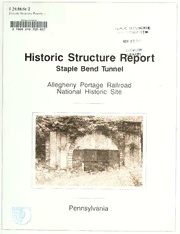
Historic Structure Report: Staple Bend Tunnel--Allegheny Portage Railroad National Historic Site PDF
Preview Historic Structure Report: Staple Bend Tunnel--Allegheny Portage Railroad National Historic Site
I 29.88:St 2 Hlsloric Slruclurc Report, .. ClemsonUnlversil II 604 019 700 857 NOV l2iV^' AHY Historic Structure ort Staple Bend Tunnel Allegheny Portage Railroad National Historic Site fifT Pennsylvania \ Printed on recycled paper historic structure report architectural data section april 1991 Prepared By: Sellardse Grigg, Inc. 143 Union Boulevard, Suite 208 Lakewood, Colorado 80228 (303) 986-1444 STAPLE BEND TUNNEL ALLEGHENY PORTAGE RAILROAD NATIONAL HISTORIC SITE PENNSYLVANIA • UNITED STATES DEPARTMENT OF THE INTERIOR NATIONAL PARK SERVICE / .. STAPLE BEND TUNNEL TABLE OF CONTENTS Preface Executive Summary L Administrative Data A. Administrative Background B. Proposed Use n. Historical Background Statement of Significance III. IV. Architectural Data Section A. Existing Conditions B. Structural Stability V. Recommendations and Cost Estimate A. East Portal B. West Portal C. Stone Lining D. Summary of Estimated Costs VI. Drawings VII. Ancillary Issues A. Site Improvements 1 Water Vault Structure 2. Electrical/Lighting B. Tunnel Access 1 Public Access 2. Public Safety 3. Construction Access 4. Interpretive Opportunities Vlli. Photographs ATTACHMENTS "Historic Structure Report, Staple Bend Tunnel, Allegheny Portage Railroad National I. Historic Site", by A. Berle Clemenson, 1990. II. GEI Consultants, Inc., Geotechnical Evaluation of Staple Bend Tunnel, Johnstown, Pennsylvania. III. "Management Report - Archeological Monitoring of Geotechnical Tests at Staple Bend Tunnel, Allegheny Portage Railroad National Historic Site", by Karen L. Orrence of Louis Berger & Associates, East Orange, New Jersey, 1991. IV. Structural Calculations PREFACE The Department of Interior has nearly completed negotiations with Bethlehem Steel Corporation to acquire property that contains various historic sites and artifacts. Among the historic sites is Staple Bend Tunnel, Allegheny Portage Railroad National Historic Site, located in Cambria County, Pennsylvania. Sellards & Grigg, Inc., and it's team were retained by the National Park Service to evaluate Staple Bend Tunnel. The specific focus of the evaluation is what would be needed to be able to open Staple Bend Tunnel to the general public as a resource with histori- cal importance. The Sellards & Grigg, Inc., team included: Sellards & Grigg, Inc., Lakewood, Colorado Civil/Structural GEI Consultants, Inc., Winchester, Mass. Geotechnical Semple Brown Roberts, P.C, Denver, Colorado Historical Architect The EADS Group, Altoona, Pennsylvania Surveyors The National Park Service has had others prepare specific reports related to other aspects of Staple Bend Tunnel. These include a historical documentation of the tunnel also entitled "His- toric Structure Report, July, 1990, prepared by A. Berle Clemenson, historian for the National Park Service, and a Management Report entitled, "Archeological Monitoring of Geotechnical Tests at Staple Bend Tunnel", February, 1991, prepared by the firm of Louis Berger & Associ- ates, Inc., East Orange, New Jersey. These documents are included in this final Historic Struc- ture Report as Attachments I and III, respectively. Sellards & Grigg, Inc., wants to thank all those who have made a contribution to this report. Thomas A. Young, P.E. Project Manager for Sellards & Grigg, Inc. Pennsylvania License No. PE-040262-R 111 EXECUTIVE SUMMARY 1. The tunnel is generally sound from a geological and structural viewpoint and can be accessible for visitation after corrective action is completed. 2. The concrete lining at the east portal provides structural support for the deformed east stone arch and should remain. 3. The east entry had a stone entry facade similar to (if not exactly like) the historic west facade. 4. Poor drainage and extensive vegetation are the main causes of deterioration to the tunnel and entries and must be addressed. 5. Historic stone retaining walls must be stabilized and enlarged and new retaining walls must be added to control erosion and structural stability. 6. A new retaining wall should be installed at and around the east entry arch to stabilize the historic arch and surrounding grade. 7. Solid infill panels or doors should be provided at each entry to weatherize the tunnel during periods of cold weather. 8. The stone lining is generally stable and needs only repointing. 9. The rock lining must be reviewed for loose, unstable material and be either removed, anchored in place or supported. V
